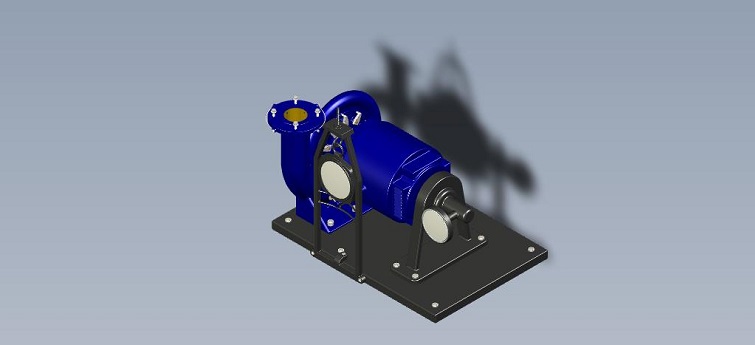Many users are unaware of the differences between a self-priming pump and a centrifugal pump. In fact, a self-priming pump is a type of centrifugal pump. The key distinction lies in the fact that self-priming pumps have a higher pump body height, providing them with a certain water storage capacity. They can draw water without the need for a foot valve to be installed in the suction pipe. This means they can bring water up after the first priming. Therefore, self-priming pumps can also be referred to as self-priming centrifugal pumps based on their functionality.
The main difference between self-priming pumps and centrifugal pumps lies in the fact that the inlet pipe of a self-priming pump does not require a foot valve to be installed. After the first priming, it can draw water up without the need for additional priming. The pump body of a self-priming pump is larger compared to a centrifugal pump. Many self-priming pumps have their own water storage function, providing a one-time priming for a lifetime of self-priming capability. On the other hand, a centrifugal pump functions by boosting pressure, and the liquid level must be higher than the pump in order for it to start. If the liquid level is lower than the centrifugal pump, a foot valve must be installed at the inlet to fill both the pump and the pipeline with liquid before self-priming can occur. This can be cumbersome in operation, especially for centrifugal pumps that have been unused for a long time. The inlet foot valve of a centrifugal pump may not achieve a completely sealed effect, leading to a slow leakage of liquid back into the tank. In situations where self-priming capability is needed, a self-priming pump offers better performance compared to a centrifugal pump.
Both self-priming and centrifugal pumps utilize a pump body structure that allows for axial return of the liquid. The centrifugal pump body is composed of an intake chamber, liquid storage chamber, vortex chamber, return hole, and gas-liquid separation chamber. After a centrifugal pump starts normally, the impeller draws in the liquid stored in the intake chamber and the air in the suction pipe together. The impeller thoroughly mixes them, and under the action of centrifugal force, the liquid, carrying the gas, flows towards the outer edge of the vortex chamber. This creates a certain thickness of white foam belt and a high-speed rotating liquid ring at the outer edge of the impeller. The gas-liquid mixture enters the gas separation chamber through the diffusion tube. At this point, due to the sudden decrease in flow velocity, the lighter gas is separated from the mixed liquid. The gas is then discharged through the pump outlet. The degassed liquid returns to the liquid storage chamber, re-enters the impeller through the return hole, and mixes with the gas from the suction pipe. Under the action of the high-speed rotating impeller, it flows towards the outer edge of the impeller once again. This process continues repeatedly until the air is completely drawn in. The self-priming pump completes the self-priming process, and the centrifugal pump enters normal operation. Due to the unique exhaust capability of this centrifugal pump, it can transport liquid containing gas without the need for a foot valve. This is particularly useful for applications like bilge pumping on ships.
Some centrifugal pumps have a cooling chamber at the bottom of the bearing housing. When the bearing temperature rise caused by heating exceeds 70℃, it is possible to connect a cooling liquid circulation through a joint at the cooling chamber, such as for IH chemical pumps. The internal sealing mechanism of the centrifugal pump that prevents leakage of liquid from the high-pressure area to the low-pressure area is composed of front and rear sealing rings. The front sealing ring is installed on the pump body, and the rear sealing ring is installed on the bearing housing. When the sealing ring wears to a certain extent due to long-term operation and affects the efficiency and self-priming performance of the pump, it should be replaced.
Centrifugal pumps are generally driven by electric motors. Before starting the pump, the pump body and the suction pipeline are filled with liquid. When the impeller rotates at high speed, the liquid between the impeller blades also rotates. Due to the action of centrifugal force, the liquid is thrown from the center of the impeller to the outer edge of the impeller (the flow velocity can increase to 15-25m/s), and the kinetic energy increases accordingly. When the liquid enters the pump casing, the flow passage in the volute casing gradually expands, and the flow velocity of the liquid gradually decreases. Some of the kinetic energy is converted into static pressure, so the liquid flows out along the discharge outlet with relatively high pressure. At the same time, at the center of the impeller, a certain vacuum is formed due to the ejection of the liquid, while the pressure at the liquid level is higher than that at the center of the impeller. Therefore, the liquid in the suction pipeline enters the pump under the action of pressure difference. The impeller keeps rotating, and the liquid is continuously sucked in and discharged. Since centrifugal pumps can transport liquid mainly by the action of centrifugal force, they are called centrifugal pumps.


